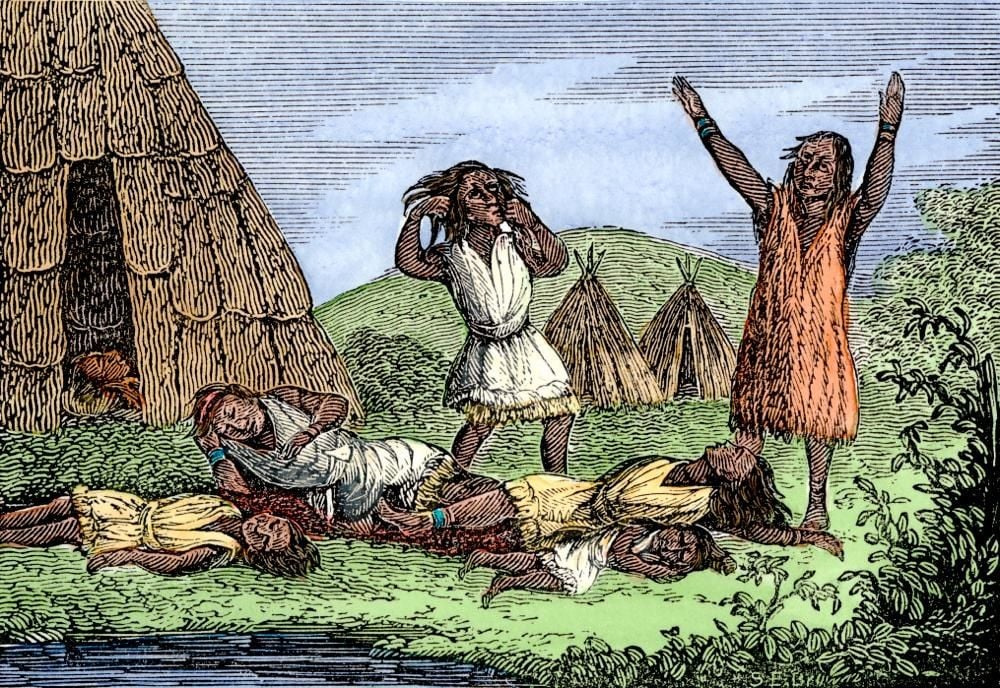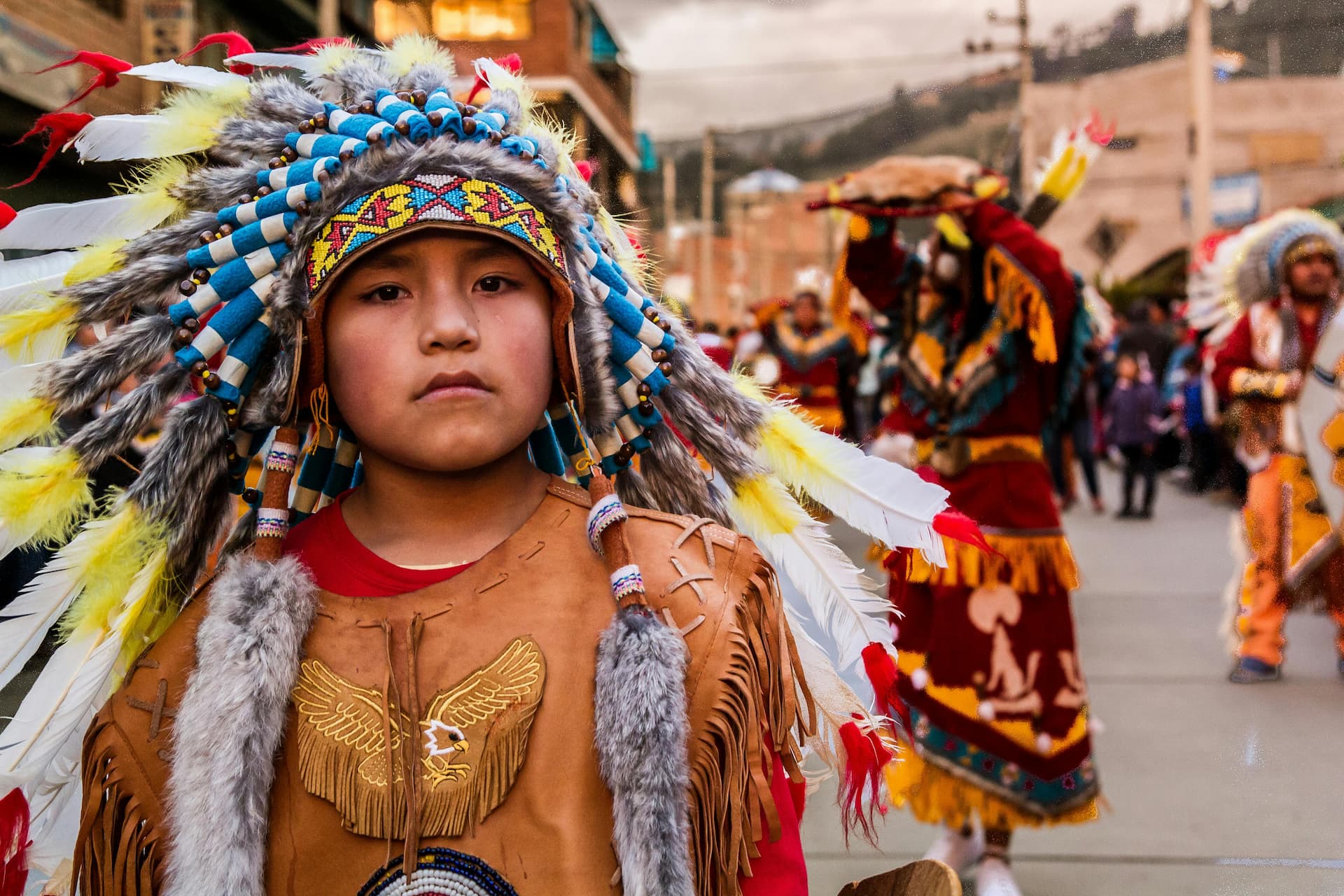American Indians and European Diseases

( – promoted by navajo)
There were an estimated 18 million Native Americans living north of Mexico at the beginning of the European invasion. Prior to the arrival of the Europeans, American Indians were remarkably free of serious diseases. People did not often die from diseases. As the European explorers and colonists began to arrive, this changed and the consequences were disastrous for Native American people. The death tolls from the newly introduced European diseases often reached 80-90 percent. Entire groups of people vanished before the tidal wave of disease.
Aboriginal Health:
If we were to compare the overall health of American Indians in North America with that of Europeans in 1500, we would find that Indians were generally healthier. There are a number of reasons for this.
First, Indians had better diets and they were less likely to face starvation and hunger. The first Europeans to reach North America often commented on the large size of the Indians. American Indians were larger than the Europeans simply due to better diets and less starvation. Unlike the Europeans, Indian political leaders did not store their wealth but accumulated prestige by giving food to those in need. No one in an Indian village or an Indian band starved unless all did so.
Secondly, American Indian populations did not have many of the infectious diseases that were endemic in Europe. A number of reasons have been suggested for this lack of disease. Some scientists have suggested that Indian people came to this continent through the cold, harsh climate of the north and that this acted as a germ filter which screened out infectious diseases. Others have suggested that Indians were disease-free because of the lack of domesticated animals. Measles, smallpox, and influenza are among the diseases which are closely associated with domesticated animals. Lacking the large domesticated animals, there were comparatively few opportunities in this hemisphere for the transfer of infections from animal reservoirs of disease to human beings.
European Diseases:
The diseases brought to this continent by the Europeans included bubonic plague, chicken pox, pneumonic plague, cholera, diphtheria, influenza, measles, scarlet fever, smallpox, typhus, tuberculosis, and whooping cough. The diseases introduced in the Americas by the Europeans were crowd diseases: that is, individuals who have once contracted the disease and survived become immune to the disease. In a small population, the disease will become extinct. Measles, for instance, requires a population of about 300,000 to survive. If the population size drops below this threshold, the virus can cause illness and death, but after one epidemic, the virus itself dies out.
Another important factor in the European diseases was the presence of domesticated animals. The source of many of the infections was the domesticated animals which lived in close proximity with the humans.
Overall, hundreds of thousands of Indians died of European diseases during the first two centuries following contact. In terms of death tolls, smallpox killed the greatest number of Indians, followed by measles, influenza, and bubonic plague.
Smallpox:
The most deadly European disease was smallpox, a disease almost unknown in today’s world but common prior to the twentieth century. Smallpox is caused by a virus that may be airborne or spread by direct contact. There are three forms of smallpox: (1) Variola major which is quite virulent; (2) Variola minor which is comparatively mild; and (3) Variola vaccinae which is also known as cowpox. An attack of any one of these forms will provide immunity against the other two.
Children resist the smallpox virus better than teenagers or adults. In a larger population, smallpox is a constant. Since nearly all children contract some form of smallpox, this means that adults have had the disease and are immune. Smallpox thus becomes a childhood disease with relatively low mortality.
When smallpox strikes a virgin population, such as the Native Americans, the initial death toll is quite high, particularly among adults and elders. As a result a great deal of cultural knowledge, such as how to conduct certain ceremonies, is lost.
Smallpox is a crowd disease. Once it strikes a low density population it soon becomes extinct in that population as it does not have enough hosts. Thus, in American Indian populations, smallpox would strike, the population would plummet, and the disease would die out. The population would begin to recover and about a generation later, smallpox would strike again.
Smallpox first struck American Indians in what is now the United States after 1520. It was not uncommon for Native people to encounter the deadly European diseases long before they encountered European people. For thousands of years, Native American trade routes interconnected the many diverse cultures on this continent. The new European diseases simply followed these trade routes, carried by both the traders and their goods. The smallpox virus can live in cloth, particularly cotton cloth, for many years.
The European diseases devastated many nations and consequently European explorers, particularly in the southeast and northeast, frequently reported finding empty villages and fields. From these reports came the common misconception that North America was only sparsely populated by Indians. In the Southeast, the Muskogee (Creek) population has been estimated at two hundred thousand before the Europeans arrived on the continent. It had declined to about twenty thousand by the time Europeans actually visited their villages.
Traditional Native American curing techniques were not effective against smallpox and many of the other European diseases. One of the primary ways of dealing with disease among most of the tribes was the sweat bath which actually increased Indian mortality from febrile diseases such as smallpox, measles, and chickenpox.
In most of the American Indian cultures, healing was a part of their religious ceremonies. When their ceremonies failed to cure the new European diseases the faith in the traditional Indian spiritual ways was also damaged. This in turn provided an opening for the Christian missionaries who were immune to the disease. Since Christians didn’t seem to die from smallpox, some Indians began to reason, then it must be the power of their religion that saved them.
Smallpox Vaccinations:
By the early 1700s, Europeans understood how smallpox was transmitted and had begun vaccination programs to prevent the disease. In North America, doctors in Boston and in Charlestown began vaccination programs about 1721. By 1800, the United States had begun smallpox vaccination programs for Indians. In 1802, for example, Indian chiefs visiting Washington were vaccinated against smallpox using a vaccine that President Jefferson had cultured. In 1804 the Corps of Discovery under the leadership of Meriwether Lewis and William Clark carried with them smallpox vaccine so that they could inoculate the tribes they encountered on their journey to the Pacific Ocean. Unfortunately, the vaccine was ruined soon after they left St. Louis.
In 1832, Congress appropriated $12,000 to vaccinate Indians against smallpox. The Secretary of War was to be in charge of the vaccinations. It was estimated that the appropriated funds were sufficient to vaccinate two-thirds of the country’s Indians. However, the Secretary of War notified the Indian agent for the upper Missouri that no tribes upstream from the Arikara were to be vaccinated. It was felt that the spread of smallpox to the tribes of the Northern Plains, such as the Blackfoot, would aid American military efforts against these groups.
Smallpox was not eradicated among American Indians until the twentieth century. The last major smallpox epidemic among an American Indian tribe was in 1921 when the disease struck the Indians living in the Pit River, California area. The impact of the epidemic was increased by starvation and lack of medical care. As usual, Congress quickly reacted to this healthcare concern: in 1928, prompted by complaints about the failure of Indian health care in dealing with the smallpox epidemic, Congress launched an investigation into charges of willful neglect. By ignoring the impact of poverty and starvation and its relation to general health conditions, the government shifted attention from its failings by stepping up attacks on shamans and blaming their influences for poor sanitary conditions.
European Views:
The early Europeans were aware that diseases were devastating the American Indian communities. In New England many of the English colonists saw the diseases as evidence of God’s plan for them to settle the area. Regarding the smallpox epidemic of 1633 which killed many Massachusett and Pawtucket, the English governor commented that the disease “cleared our title to this place.”
Many Europeans, both Spanish and English, see the devastating diseases as evidence of God’s wrath directed toward the Indians and evidence of the sinful life of the Indians. Many Protestants, particularly Calvinists, viewed disease as a divine punishment for sin. Since American Indians were heathens-the greatest sin of all-it was natural that God should destroy them with smallpox. Similarly, the Catholic priests in California attributed diseases such as smallpox to tribal sin, especially the cardinal sin of refusing to believe in Christ.
However, there were some Spanish priests who felt that the diseases which were devastating Indian populations were an indication of God’s wrath against the Spanish colonists. They see the depopulation of the Indian communities as depriving the Spanish of their labor force.
Syphilis carried from America to Europeans?:
At one time it was commonly assumed that syphilis originated in the Americas and was initially brought back to Europe by the first Spanish sailors. This assumption was based on the fact that the disease first began to be reported in Europe shortly after Columbus returned from his first voyage to the Americas. However, the archaeological record, in the form of burials in England, has disproved this assumption. At Hull, four skeletons of individuals who had died in the mid-fifteenth century show fully developed tertiary syphilis. This is evidence that the disease was already well established in Europe at least a half a century before Columbus set sail.

